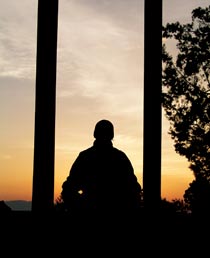| Home of Kung Fu Fights for its Soul |
| http://www.sina.com.cn 2004/11/25 20:53 thats China |
 Kong Fu Destroyed three times by war, Shaolin Temple now faces its biggest challenge ever - its own success. By Richard Baimbridge This sacred burial ground has seen many a great battle over the 15 centuries since it was founded, but none greater than the one it faces today. Renowned throughout the world as the birthplace of modern martial arts, it's all but impossible to separate the facts from the myths about Song Shan Shaolin Temple. Many of the historical records, like the original Henan province temple itself, have been destroyed throughout periods of fighting. And it doesn't help much that the world of kung fu is fertile soil for storytelling fantasies. But pondering its history makes one wonder: What is it really like at Shaolin today?
"[Some] of the great masters have left," claims Jin Kong, a 47-year-old Shaolin master now living in Yunnan. "Things have definitely changed at Shaolin." Jin Kong also left Shaolin Temple, back in 1982, just before things began to change. "Back then, we would practice in the pagoda garden," the master recalls, and then demonstrates by slamming his fist into his palm and stomping his foot into the ground, letting out a very intimidating "Eee-yah!" He adds: "There were only a few people visiting the temple then; and just a few monks. It was..." he shakes his head and smiles, unable to find the words "...wonderful." Once upon a time An Indian monk named Ba Tuo founded Shaolin Temple in about the 5th century AD. In 539 AD, another wandering Indian monk named Bodidharma (known as Da Mo in Chinese) came upon Shaolin Temple. At first the abbot refused him entrance, so he retreated to a nearby cave and meditated until he won the respect of the monks. Da Mo preached Zen meditation, but found the Shaolin monks physically unfit to sit for long periods. After much contemplation, he devised a series of exercises based on yoga designed to keep the body strong. It served two purposes in that Shaolin monks were also frequently prone to bandits, and the exercises could be used in self-defense when necessary. |
|
|
|
|
|
| Annotation |
| 新闻查询帮助 | |
| 热 点 专 题 | ||||
| ||||
|
教育频道意见反馈留言板 电话:010-62630930-5178 欢迎批评指正
新浪简介 | About Sina | 广告服务 | 联系我们 | 招聘信息 | 网站律师 | SINA English | 会员注册 | 产品答疑
Copyright © 1996 - 2004 SINA Inc. All Rights Reserved
版权所有 新浪网![]() 北京市通信公司提供网络带宽
北京市通信公司提供网络带宽
